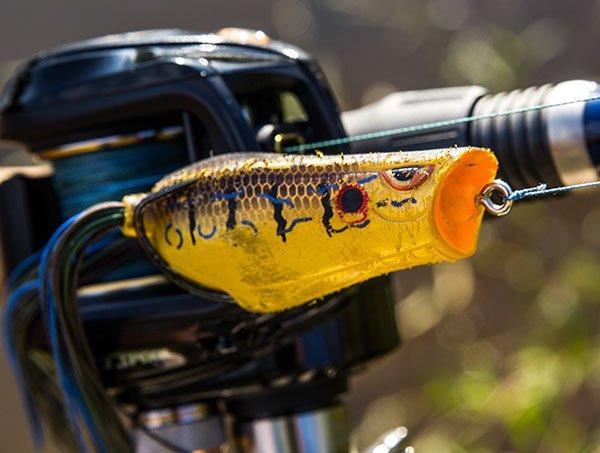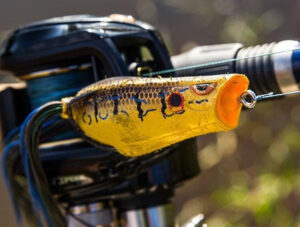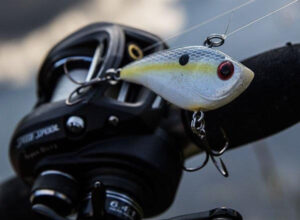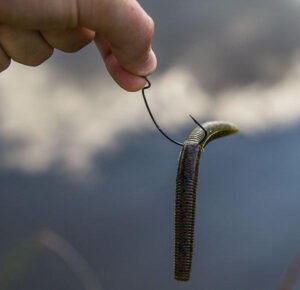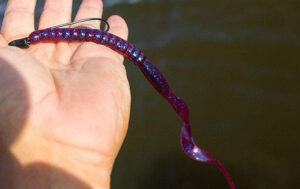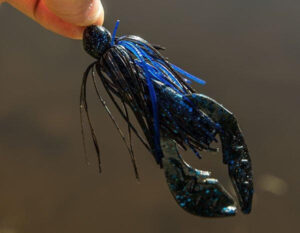Narrowing down your bank fishing tackle selection can be quite difficult at times. Not all of us can afford high-dollar equipment, so we have to embrace simplicity and learn to catch fish with the gear we have available.
Fortunately, bank fishing can be quite productive throughout the fall. Whether you’re a full-time bank angler or just escaping the hustle-and-bustle of big fisheries, this is a great time of year to catch a lot of bass from shore. Over the years, I’ve found 5 affordable bank fishing baits that will cover the water column and catch bass regardless of the conditions or mood of the fish.
Topwater frogLipless crankbaitWacky rigged stick wormTexas rigged big wormFinesse jig
Topwater frog
Whenever you’re fishing a small pond, it’s essential to have a topwater frog within reach. I’ve never fished a pond in lowlight hours without hearing frogs croaking and there’s a good reason for it—ponds are frog magnets. If you’re hearing frogs, you can bet they are on the bass’ menu.
Vegetation—Topwater frogs, such as the SPRO Bronzeye Poppin’ Frog, are an excellent choice when there’s any type of vegetation in the body of water you’re fishing. Put aside all the technical mumbo jumbo about grass species and water depth—if there’s grass in a pond, bass will eat a frog. Target small irregularities in the vegetation for the most explosive action.Laydowns—If you’re fishing a public lake or pond from shore, you need to differentiate your presentation from other anglers’ because the bass are probably pressured. Instead of casting generic Texas rigs to laydowns, skip a frog underneath branches and overhangs. Chances are, not many folks are doing it, so you can catch the bass off-guard by showing them something new.If it smells fishy—When you’re walking the banks of your favorite pond, sometimes it smells fishy. While it can certainly be crappie you smell, there’s a good chance you’re smelling a population of shallow bream. Popping topwater frogs are great imitation of feeding bream, so find a green-colored frog and start chunking it parallel to the bank.If you hear frogs—This is a dead giveaway. If you hear frogs croaking, there might as well be a neon sign above the water telling you to throw a frog. Frogs are an easy, protein-rich food source for bass and pond bass are never shy about showing their affinity for them.
Lipless crankbait
I’ve caught a lot of bass on generic squarebill crankbaits from shore, but it’s definitely a frustrating endeavor. As you retrieve the crankbait back to shore, the lip will cause it to dig into the shallows, often resulting in a tangled mess of treble hooks and pond muck. For better depth control, try a small lipless crankbait.
Surface activity—If you see surface activity from the bank, an Xcalibur Xr50 Rattle Bait is an outstanding option. The weightlessness of it gives you the option to fish it on both casting and spinning gear, and the small profile often matches the size of available bass forage in ponds.Long casts—When a long cast is necessary to reach that sexy-looking piece of cover, it’s hard to beat a lipless crankbait. Regardless of your equipment, they cast like a bullet and will help you cover water when other baits fall short.Windy conditions—Bank fishing in the wind can be frustrating, but a lipless crankbait helps you overcome it. They cast well against the wind and allow you to target hard-to-reach, windblown areas in which shad are prone to congregate. Not to mention, there’s something about wind and a lipless bait that drives big bass crazy.
Wacky rigged stick worm
Perhaps my favorite pond bait is a wacky rigged stick worm. I use both 5-inch Yamamoto Senkos and YUM F2 Dingers, which are both easy to find at most major retailers. If I’m having trouble getting bites on a Texas rig, a wacky rig is my immediate follow-up choice.
Swirling bass—If you’re noticing bass swirl in the shallows as you approach the shoreline, make sure to make a few casts with a wacky rig. You’ll often catch your biggest bank fish on your first few casts, and the subtle profile of this rig is great for “sneaking up” on big, wary bass. Simply let it fall on a slack line for a few seconds, twitch it two or three times and wait for your line to swim to the side.Grass lines—When you’re not getting bit inside thick vegetation, try targeting the edges of it with a wacky rig. If there’s a nearby break line adjacent to the grass bed, your bigger bass will often suspend on the edge to be closer to deep water.Vertical structure—Wacky rigs are a great choice for targeting vertical structure such as old fence posts or stumps. Whether the bass are suspended on the cover or holding close to the bottom, you’ll be able to cover the entire water column with this technique. Just make sure you allow it to fall on a completely slack line.
Texas rigged big worm
Big worms are a primary pattern on most big fisheries throughout the summer, but I’m telling you—they work year-round when fishing in ponds. Whether the bass mistake them for snakes or big leeches, it’s a technique that catches thousands of big bass every year from shore.
- Heavy cover—I usually stick with a 3/8-ounce tungsten bullet weight and a 5/0 or 6/0 hook around heavy cover. Flip the big worm in the thickest parts of the laydown and barely twitch your rod tip, just as you’d fish a shaky head. I’ve been doing really well on a YUM Ribbontail Worm because it doesn’t take much movement for the big tails to displace water.
- Shallow flats—I honestly don’t know why this works, but it does. When you notice a shallow flat from shore, simply swim a big worm slowly across the bottom. This works well in the summer on bigger fisheries, but it’s a year-round technique on small ponds. Bites often feel “mushy”, similar to a Carolina rig bite, so make sure you pay close attention to what you’re feeling.
- Break lines—In most bank fishing scenarios, there will be a small break line within roughly 10 feet of the shore. Pond bass don’t always have a lot of options for structure, so they’ll congregate near small depth changes, especially after a weather front. If you just drag the worm slowly, you should be able to coerce a few big ones to bite.
Finesse jig
Big jigs can be effective in some ponds, but small jigs tend to outperform them when bank fishing in the fall. While larger jigs get covered in crud and bury into nasty pond bottoms, a smaller jig will sit on top of the soft, bottom layer of most ponds.
- Feeder creeks—When you see a feeder creek leading into a pond, that should be a sign to break out a small jig, like a 3/16-ounce Strike King Bitsy Bug Jig. Crawfish love hanging around the mouths of these feeder creeks, so if you can get within casting distance, you’re in good shape to catch bass.
- Ditches—In rare situations, you’ll actually be able to feel a sharp depth change while bank fishing. When you’re dragging a Texas rig across the bottom and feel it drop off into deeper water, try switching to a small jig. Hop it as close as possible to the depth change and make sure to be ready. Ditches, however small, can produce some outstanding action.
- Dams—If you bank fish near the dam of a small pond, make it a point to try out a small jig. This is where you’ll often find the most dramatic depth changes, and just like the ditches I discusses, something about a small jig on near pond depth changes is extremely effective.
Bank fishing for bass requires the angler to be very mobile and adaptive. Instead of lugging a huge tackle box everywhere you go, try to stick with these 5 baits and presentations next time you go out. Not only will it lighten your load, but it will also result in a lot of fish catches for you.
What are your most effective bank fishing baits? Did I leave anything out? Let me know in the comments below!


